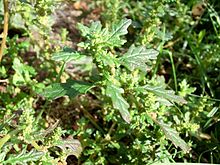Dysphania pumilio
(Redirected from Teloxys pumilio)

Taxonavigation
edit| Taxonavigation: Caryophyllales |
|---|
| Classification System: APG IV
Superregnum: Eukaryota |
Familia: Amaranthaceae s.l.
Cladus: Chenopodiaceae s.str.
Subfamilia: Chenopodioideae
Tribus: Dysphanieae
Genus: Dysphania
Sectio: Dysphania sect. Dysphania
Subsectio: Dysphania subsect. Orthospora
Species: Dysphania pumilio
Name
editDysphania pumilio (R.Br.) Mosyakin & Clemants, Ukrayins'k. Bot. Zhurn. 59(4): 382. (2002)
Synonyms
edit- Basionym
- Chenopodium pumilio R.Br., Prodr. Fl. Nov. Holland. 407. (1810)
- Typus: South Australia: Kangaroo Island, 1802-03-21, R. Brown #3033. Holotype: BM BM001010202. Syntype: MEL607120
- Homotypic
- Ambrina pumilio (R.Br.) Moq., Chenop. Monogr. Enum. 42. (1840)
- Blitum pumilio (R.Br.) C.A.Mey. ex Steud., Nomencl. Bot. [Steudel], ed. 2. 1: 210. (1840)
- Teloxys pumilio (R.Br.) W.A.Weber, Phytologia 58(7): 478. (1985)
- Neobotrydium pumilio (R.Br.) M.L.Zhang & G.L.Chu, Pl. Diversity 38(6): 327. (2016)
- Neobotrydium pumilio (R.Br.) G.L.Chu, Gen. New Evol. System World Chenopod. 74. (2017), isonym
- Heterotypic
- Blitum glandulosum Moq., Prodr. [A. P. de Candolle] 13(2): 82. (1849)
- Typus: "In Novâ-Hollandiâ. ... (v.s. in L. Desf., Poir., DC. et Webb.)"
- Lectotype: Australia: Nova Hollandia, R.L. Desfontaines #s.n. P00606458.
- Chenopodium glandulosum (Moq.) F.Muell., Fragm. (Mueller) 7(50): 11. (1869)
- Chenopodium pumilio f. glandulosum (Moq.) Aellen, Verh. Natur!. Ges. Basel 44: 315. (1933)
- Chenopodium pumilio var. oblongifolium J.M.Black, Fl. S. Australia (ed.2) 2: 289. (1948), nom. inval. (no Latin diagnosis)
- Misapplied names
- "Chenopodium carinatum" R.Br.
Distribution
edit| Native distribution areas: |
|---|
widely introduced and naturalized References: Brummitt, R.K. 2001. TDWG – World Geographical Scheme for Recording Plant Distributions, 2nd Edition |
References
editPrimary references
edit- Aellen, P. 1933. Die Arten der Sect. Orthosporum der Gattung Chenopodium L. Verhandlungen der Naturforschenden Gesellschaft in Basel 44: 308–318. Reference page.
- Black, J.M. 1948. Flora of South Australia. Part II, Casuarinaceae – Euphorbiaceae. (ed. 2). Adelaide, Govt. Printer. 521 p. Reference page.
- Brown, R. 1810. Prodromus Florae Novae Hollandiae et Insulae Van Diemen. pp. i–viii + 145–590, Londini: R.Taylor. BHL Reference page.
- Moquin-Tandon, A. 1840. Chenopodearum Monographica Enumeratio. P.-J. Loss, Paris. BHL Reference page.
- Moquin-Tandon, A. 1849. Salsolaceae. In: De Candolle, A.P. (ed.): Prodromus systematis naturalis regni vegetabilis 13(2): 41–219. Masson, Paris. BHL Reference page.
- Mosyakin, S.L. & Clemants, S.E. 2002. New nomenclatural combinations in Dysphania R.Br. (Chenopodiaceae): taxa occurring in North America. Ukrayins'kyi Botanicnyi Zhurnal 59(4): 380–385. Reference page.
- Mueller, F.v. 1869–1871. Fragmenta Phytographiae Australiae. Vol. 7. 166 pp. J. Ferres, Melbourne. BHL Reference page.
- Steudel, E. 1840. Nomenclator botanicus. Seu: synonymia plantarum universalis, enumerans ordine alphabetico nomina atque synonyma, tum generica tum specifica, et a Linnaeo et a recentioribus de re botanica scriptoribus plantis phanerogamis imposita. Editio secunda ex nova elaborata et aucta. Pars I: Lit. A–K. 852 pp. Typis et sumptibus J. G. Cottae, Stuttgartiae [Stuttgart] et Tubingae [Tübingen]. BHL Reference page.
- Weber, W.A. 1985. The genus Teloxys (Chenopodiaceae). Phytologia 58(7): 477–478. BHL Reference page.
- Zhang, M.-L. & Chu, G.L. 2016. Resurrection of the genus Botrydium Spach (Chenopodiaceae), with a description of four new species from China, Peru and Burundi. Plant Diversity 38(6): 322–329. DOI: 10.1016/j.pld.2016.10.005 Reference page.
- Zhu, G.L. & Sanderson, S.C. 2017. Genera and a New Evolutionary System of World Chenopodiaceae. 361 pp. Beijing: Science Press. Reference page.
Additional references
edit- Mosyakin, S.L. 2021. Nomenclatural and taxonomic comments on some taxa of Dysphania (Chenopodiaceae s. str. / Amaranthaceae s. l.). Ukrayins'kyi botanichnyi zhurnal 78(4): 266–273. DOI: 10.15407/ukrbotj78.04.266 Reference page.
- Uotila, P., Sukhorukov, A.P., Bobon, N., McDonald, J., Krinitsina, A.A. & Kadereit, G. 2021. Phylogeny, biogeography and systematics of Dysphanieae (Amaranthaceae). Taxon 70(3): 526–551. DOI: 10.1002/tax.12458 Reference page.
- Clemants, S.E. & Mosyakin, S.L. 2003.
- eFloras 2008. Dysphania pumilio in Flora of North America. Missouri Botanical Garden, St. Louis, MO & Harvard University Herbaria, Cambridge, MA.
Links
edit- Australian Plant Name Index (APNI) 2016. Dysphania pumilio Integrated Botanical Information System (IBIS). Australian National Botanic Gardens & Australian National Herbarium. Accessed: 2016 Mar. 18.
- Hassler, M. 2018. Dysphania pumilio. World Plants: Synonymic Checklists of the Vascular Plants of the World In: Roskovh, Y., Abucay, L., Orrell, T., Nicolson, D., Bailly, N., Kirk, P., Bourgoin, T., DeWalt, R.E., Decock, W., De Wever, A., Nieukerken, E. van, Zarucchi, J. & Penev, L., eds. 2018. Species 2000 & ITIS Catalogue of Life. Published online. Accessed: 2018 Nov. 27. Reference page.
- International Plant Names Index. 2016. Dysphania pumilio. Published online. Accessed: Mar. 18 2016.
- Govaerts, R. et al. 2021. Dysphania pumilio in Kew Science Plants of the World Online. The Board of Trustees of the Royal Botanic Gardens, Kew. Published online. Accessed: 2021 Oct. 13. Reference page.
- Tropicos.org 2021. Dysphania pumilio. Missouri Botanical Garden. Published online. Accessed: 13 Oct. 2021.
Vernacular names
editčeština: Merlík trpasličí
Cymraeg: Troed-yr-ŵydd Awstralia
Deutsch: Australischer Drüsengänsefuß, Australien-Drüsengänsefuß, Australischer Gänsefuß
English: clammy goosefoot, small crumbweed (Australia: Boggabri, Mintweed)
suomi: Australiansavikka
Nederlands: Liggende ganzenvoet
svenska: Pygmémålla
Cymraeg: Troed-yr-ŵydd Awstralia
Deutsch: Australischer Drüsengänsefuß, Australien-Drüsengänsefuß, Australischer Gänsefuß
English: clammy goosefoot, small crumbweed (Australia: Boggabri, Mintweed)
suomi: Australiansavikka
Nederlands: Liggende ganzenvoet
svenska: Pygmémålla
| For more multimedia, look at Dysphania pumilio on Wikimedia Commons. |